#St. Michael's Church Ghent
Explore tagged Tumblr posts
Text

Golgotha, Anthony van Dyck, 1630
#Good Friday#Holy Week#Crucifixion#liturgical year#liturgical calendar#art#art history#Van Dyck#Anthony van Dyck#religious art#Biblical art#Christian art#Christianity#Catholicism#New Testament#Gospels#Baroque#Baroque art#Flemish Baroque#Flemish art#17th century art#oil on canvas#St. Michael's Church Ghent
230 notes
·
View notes
Text

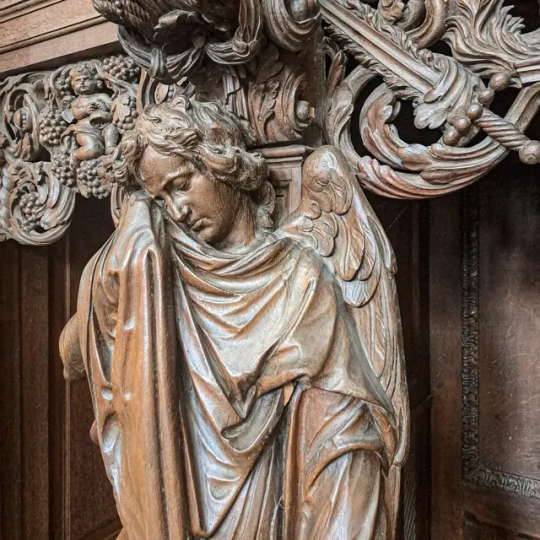
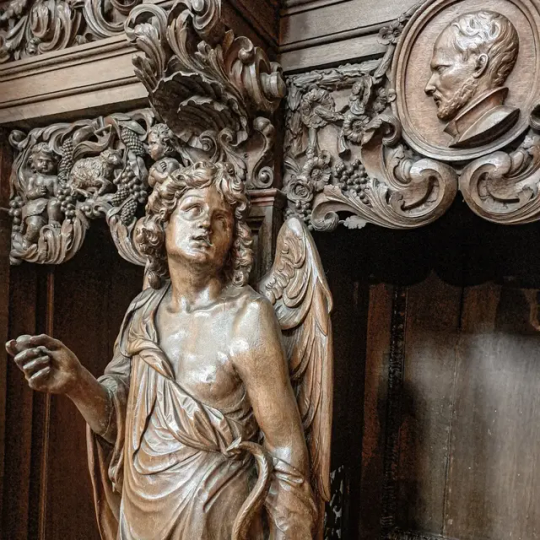
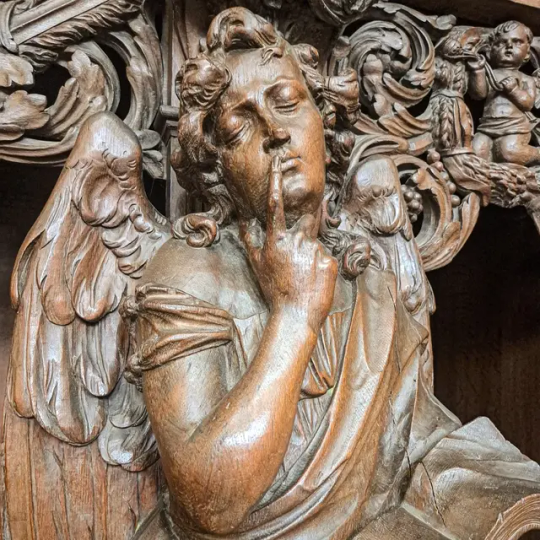
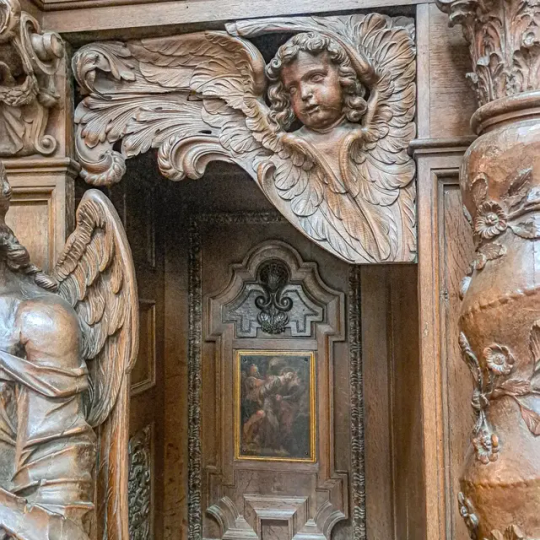
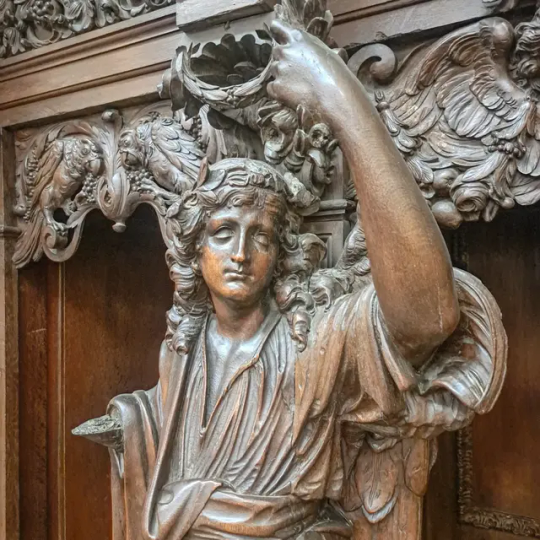

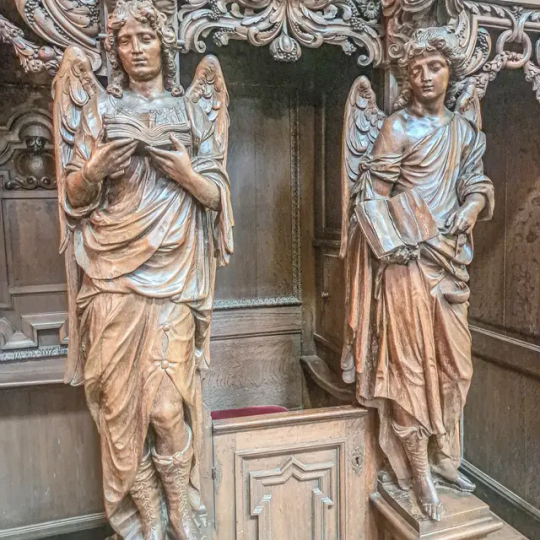
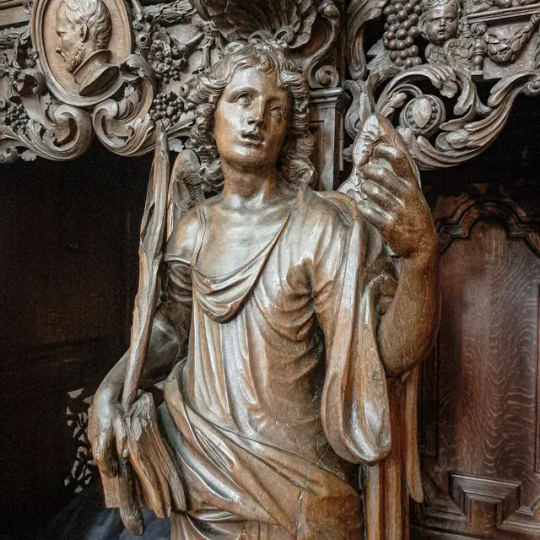

Confessionals in Saint-Michael's church (dutch/flemish: Sint-Michielskerk) in Leuven, Belgium are a beautiful example of flemish/brabantine baroque woodsculpting.
In 1650 the Jesuit order in Leuven decided to build a new church for their monastery in Leuven. For this purpose they appealed to their colleague Willem Hesius (1601-1690), who at that time was director of the Latin Sodality in Brussels and confessor of Archduke Leopold-Willem, the governor of the Spanish Netherlands. The church in Leuven is his first important architectural project. His other projects include the plans for the Jesuit College of Ghent and the design for the main altar of St. Rumbold's Cathedral in Mechelen. The pulpit, confessionals and communion rails were aligned with the general concept of the church.
#europe#historic buildings#architectural history#belgium#historical#historical interior#history#art history#flanders#wood carving#woodworking#wood sculpture#sculpture#angel#ange#angelic#carpentry#confession#confessional#architecture#churches#church#eglise#iglesia#igreja#kirche#kerk#church interior#religion#religious art
41 notes
·
View notes
Photo
Joseph Paelinck, (20 March 1781 – 19 June 1839) was a painter from the Southern Netherlands.
Paelinck attended the Royal Academy of Fine Arts (Ghent) and then with Jacques-Louis David in Paris, where he painted in 1804 A Judgment of Paris, which earned him his first Academy Art Award for Ghent. After he had worked there a short time as a teacher, he went to Rome and stayed there for five years. He painted, among other things: Rome under Augustus for the Quirinal Palace and the Discovery of the Cross for St. Michael's Church in Ghent. He was later a professor at the Académie royale de peinture et de sculpture in Brussels.
His many pupils included Charles Baugniet, François Antoine Bodumont, Edouard de Bièfve, Élisa de Gamond, Félix De Vigne, Jean Joseph Geens, Jozef Geirnaert, Joseph Meganck, Fanny Paelinck-Horgnies, Alfred Stevens, Joseph Cohen de Vries and Abraham Johannes Zeeman.
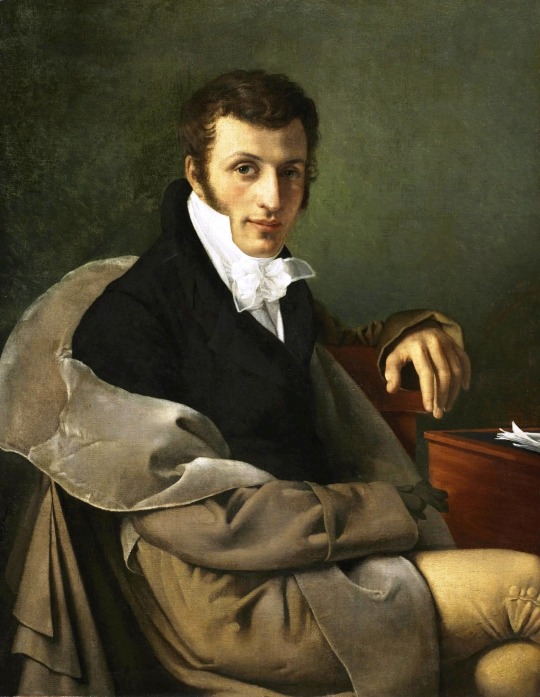
Joseph Paelinck, 1812 - Self-Portrait
127 notes
·
View notes
Photo

Jan Janssens - The Resurrection of Christ -
oil on canvas, height: 170.8 cm (67.2 in); width: 129.3 cm (50.9 in)
Jan Janssens (August 1590 in Ghent – after 1650) was a Flemish Baroque painter and draftsman who is considered to be the most important of the so-called Ghent Caravaggisti. These Caravaggisti were part of an international movement of European artists who interpreted the work of Caravaggio and the followers of Caravaggio in a personal manner. Janssens altarpieces and other compositions offering very realistic representations of religious motifs adorn many churches in and around Ghent. He also worked on commissions for international patrons.
Jan Janssens’ known work is fairly limited. During his stay in Italy Janssens came into contact with Dutch painters like Dirck van Baburen, Gerard van Honthorst and Hendrick ter Brugghen. These Dutch artists were followers of the style of Caravaggio and are known as the Dutch or Utrecht Caravaggisti, after their main centre in Utrecht, where there was still a sizeable and prosperous Catholic population. Their work influenced him stylistically. He was also influenced by the work of Bartolomeo Manfredi. Janssens took the Caravaggio style back with him to Ghent and he is considered to be one of the Ghent Caravaggisti along with Antoon van den Heuvel and Melchior de la Mars. He worked principally on commissions for altarpieces.
His chief subject matter are biblical and, to a lesser extent, mythological themes painted in a large format. His favourite themes are Christ crowned with thorns and the mocking of Christ. He also returned various times to the theme of the Caritas Romana, even making one version (1620-1625, Real Academia de Bellas Artes de San Fernando) based very closely on a work by Dirck van Baburen on the same theme.
He also painted various versions of the Resurrection of Christ. The principal version is the one in the St. Salvator's Cathedral in Bruges. In this composition he shows his originality and his independence of the Utrecht Caravaggisti and other Caravaggisti. The inspiration for the work may be an anonymous Italian Mannerist drawing. In this work he also made an effort to depict the materials such as the weapons and armour, beards, fabrics, fur and drums in a very realistic manner. He also distanced himself from the Utrecht Caravaggisti by not giving the figures excessive expressions but rather realistic emotional expressions.
Janssens' work conforms to the prescriptions of the Counter Reformation and the Baroque through its merciless and sober realism and dramatic effects with hidden light that shines on his figures. These effects were intended to ensure a strong emotional impact on the viewer.
One of his masterpieces is The Martyrdom of Saint Barbara (which in fact deals with Saint Agatha), which is kept in the Saint Michael's Church, Ghent.
52 notes
·
View notes
Photo

St Michael’s Bridge crossing the Leie river and heading towards the 13th century Gothic Saint Nicholas Church in the historic center of Ghent, Flanders, Belgium. via /r/ArchitecturePorn https://www.reddit.com/r/ArchitecturePorn/comments/otcdl7/st_michaels_bridge_crossing_the_leie_river_and/?utm_source=ifttt
1 note
·
View note
Text
Mystery Michael
Ok prof. Langdon, get ready for some real iconography. I stumbled on this problem a while ago in the church of St. Bavo in Ghent and I need to put my thoughts on paper - so why not use Tumblr? Maybe someone comes along and solves the mystery.
In St. Bavo’s crypt, there is this painting:

(excuse the horrible angle & quality)
I’m 99% sure I have seen this exact picture - albeit in vastly better quality - before. It’s famous. Known. Except not by Google, it seems.
Below is my frustrating journey to find Mystery Michael’s hidden origins; what was supposed to be 10 minutes of Googling turned into a rabbit hole full of archangels.
Being certain this was a direct copy of a famous painting, I very cleverly DID NOT take a picture of the little information card. (pro-tip for any aspiring art historians: always take pictures of informations cards. always.) I think I remember it being described as either 16th-century. On reviewing the photo, I’m not entirely sure of that anymore, but let’s operate on the assumption for now that this picture is Flemish 16th-century.
As you may guess, it turned out the ‘very famous painting’ I was 99% sure this was copied after is unfindable. What I thought it looks like most is the following:

Luca Giordano’s Archangel Michael Hurls the Rebellious Angels into the Abyss painted circa 1666 (nice number), now in Vienna. Same legs, same outfit, same colors, same swirly rope. Totally different upper body and head position. However, this painting dates a wee bit late to be considered any kind of ‘origin’ for the mystery picture (still assuming a 16th-century date). Luca helpfully painted another St. Michael though:

Giordano’s St Michael of circa 1663, now in the Gemäldegalerie in Berlin. The upper body is slightly closer, but the outfit is different. Again those feet, though.
Those feet...
Turns out, a whole lot of St. Michaels are depicted with those feet because my dear friend Rafael (the painter, not the ninja turtle) painted a Michael with those feet.

There we go. Raphael’s Saint Michael Vanquishing Satan of 1518, currently in the Louvre. It’s pretty big too, measuring almost 3 meters. Definitely the origin of the general pose of these other Michael’s and especially the feet - but not the outfit or the exact upper body of our mystery painting.
Now Luca Giordano is kind of a known copy-cat who cherry-picked bits and pieces from other pictures to compose his own. Not a unique strategy at all, but he was really kinda obvious about it. So if Luca’s pictures are really close, maybe he copied bits of the picture I believe my mystery picture is directly copied after. Or so I supposed...
Pieces of the outfit return on another painting which seemd to have passed into common catholic visual memory as it’s on an astounding amount of post-cards and bible websites:

Guido Reni’s c. 1636 Archangel Michael from the Santa Maria della Concezione, Rome - also measuring nearly 3 metres. Could this be the template for Michael’s blue and gold armor?
Maybe not, as I unearthed an even earlier picture (c. 1610) by Giuseppe Cesari, aka the Cavaliere d’Arpino, which shows the same outfit, but with helmet.

(also in Vienna btw.)
At this point though, Google images stopped being helpful as catholics (or algorithms) are really keen on selling the same 5 St. Michael pictures on anything you can remotely stick an image on - tote bags, phone cases, you know the drill - and any ‘St. Michael painting’ query quickly devolves into a collection that would put AliExpress to shame.
There are two further lucky finds though that I would like to call your attention to (kudos to those who are still reading at this point!)

A statue of Michael outside Sankt Michael in Vienna. Again. Based on what Wikipedia has to offer, the figures were sculpted in 1725 by Lorenzo Matielli. The general feel is much older though, as the pose, design and details approach the paintings cited above. And of course, there are the Rafael feet again. Interestingly though, Michael has he (almost) exact same pose as the mystery painting. Since the sculptor seems to have looked pretty closely at 16th- and 17th-century painted examples - is this another clue that the original mystery painting really exists?
And then Google threw me this last bone, somewhere deep in its dregs of images:

A “Spanish colonial work” from New Mexico, dated late 19th or early 20th century. Google “San Miguel arte” and a whole world of Spanish/Mexican images of the angel Michael in roughly this pose pop up. All of them are very like each other and not like the paintings above. The chain seen here is often exchanged for scales:

So weird as it is, these modern South American paintings (this one hails from Cuzco if Ebay is to be believed) are the closest relatives to the Mystery Michael.
But neither chain nor scales occur in some earlier Spanish paintings I found, which introduce the head-tilt and the helmet, but faithfully copy Rafael’s spear.
So - are these South-American painters, the artist behind the mystery michael, and I suffering from a very long-lasting case of Mandela Effect? Or is there indeed an original painting, perhaps Flemish or Spanish in origin, that all these works have copied?
To be continued... (hopefully)
#art history#iconography#original#saint michael#archangel#fall of the rebel angels#lucifer#satan#art#painting#history
18 notes
·
View notes
Text
Warm Flanders
Indulging our traveling desire and continuing the newly developed tradition of European Christmas markets, we bought tickets to Belgium. This trip had its peculiarities - and a unique aftertaste. Welcome to the capital of Europe!

Panorama of Bruges from Belfry (I assume, the point where Brendan Gleeson's character jumps off in the movie 'In Bruges'
I don't know how we chose Belgium - but it all started with just Brussels, and then grew to another three towns. I suspect we may have a psychological condition.
After Brussels, Bruges was an obvious addition to the trip. Possibly the most well-known of tourist destinations in Belgium, it features a well-preserved medieval town so quaint like it crawled out of a fairy tale.
The movie 'In Bruges' (a nice piece of popularized arthaus) added to the fame of the place. The town in this flick is a character of its own - it serves as the premise and the plot twist, it helps to make hard choices and aids the protagonist. Besides, the film has gorgeous cast. Seriously, look it up if you've never seen it - or rewatch if you have.
Being in Belgium (and, more importantly, its northern part, Flanders - probably the most history-heavy region), I absolutely had to see Antwerp. Ghent was a curious little addition that we didn't plan - but that happened between Bruges and Antwerp just because we had time and opportunity. Stay tuned for more.
Brussels: Art and Chocolate

Rue de la Chaufferette/Lollepotstraat, LGBTQ art street in the inner City of Brussels
Brussels is a weird city. Commonly I enjoy places that don't mind you roaming the streets (think Rome, Bangkok, New York). Brussels is however different. It etched into my memory as grey and rainy (I barely got a chance to snap a photo), and multifaceted to the point of utter incomprehensibility.
That is partly on national communities. Our free-tour guide mused on the immigration agenda of the city: nearly 80% of the current population (first and second generations) are not native to Belgium. The city, being the administrative and political center of Europe, is the very definition of a cultural melting pot.
Only a day before we arrived, French workers had a strike against ever-growing prices - thus all of Brussels was covered in barricades (not sure about the name, but something like Cheval de frise or knife-rest (aka Spanish rider) obstacles; all cold metal and barbwire, brutal).
But Brussels also flaunts its historic heritage and celebrates its art. The whole city is covered in street art - most notably scenes and characters from comics and statements in favor of LGBTQ community. Street decorations and overhead lamps of different designs and splendor turn the city into an exhibition of light.

Altmejd, 2015. Musees royaux des Beaux-Arts de Belgique/Koninklijke Musea voor Schone Kunsten van Belgie
The more traditional artistry is spread within the cluster of museums of Mont des Arts/Kunstberg, most notably the Royal Museu of Fine Arts that features both old masters (David, Rembrandt, Rubens - and a whole hall and Google-partnered tour program dedicated to Bruegel) and new masters (some of my beloved Impressionists including Van Gogh, Serat, Gaugin, and a couple of Rodins). Another pearl, Magritte's museum is just down the stairs.
We've also followed one of the most bizarre quests I've ever had, looking for all three pissing monuments of Brussels - the symbol-status Manneken Pis, his female version Jeanneke Pis and a non-fountain canine variation Het Zinneke. Belgian people are weird.
We had some hysterical fun trying to decipher one of the ads on a bus stop. It claimed certain Subea was the best gift for your loved ones on Christmas. Passersby undoubtedly believed us crazy as we tried to identify the thing - and never came close to guessing. Look it up, it's hilarious.

Blue street art, Brussels
Built on the time-tested principles of trading cities, Brussels preserves the tradition of market squares. In early December, the downtown is covered in Christmas towns and motley crowds, framed in softly shimmering lights. It's full of flavors of waffles with cream, and frites, and gluhwein, and seafood, and sausages.
Brussels is full of cyclists (even more so than Copenhagen), full of churches, and homeless, and nationalities - cuisines, skin tones, languages. The signs duplicated in French and Dutch do not help location purposes in any significant way.
Nevermind the confusing feelings I developed for Brussels, there is one thing I should mention with firm praise - chocolate. Walk the streets and have a cup of hot chocolate - it's literally chocolate of your choice melted in hot milk. Eat warm Liege waffles topped with chocolate and cream. Buy a set of (regular) chocolate boxes with discount - or pay a visit to Galeries Royales Saint-Hubert to learn about chocolate as art. It's expensive, yes, but oh is it worth every cent!
Break a chocolate bar of preference - dark works best - into pieces, add to the cup and pour with hot milk. Stir until it melts. Enjoy the taste of Belgium.
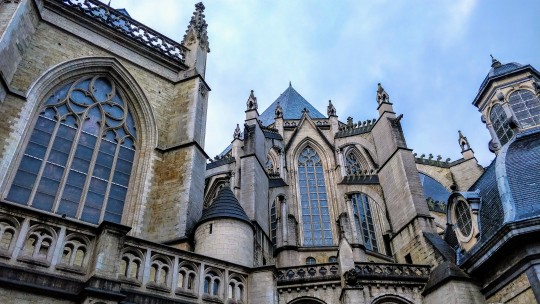
St Michael and Gudula Cathedral, Brussels
What to see in Brussels:
Grand Place
Brussels Town Hall
Residence of the Dukes of Brabant
Maison du Roi/Broodhuis
Manneken Pis
Jeanneke Pis
Het Zinneke
Bourse/Beurs (stock exchange)
Galleries Royales Saint-Hubert
St Michael and Gudula Cathedral
chapelle de la Madeleine/Magdalenakapel
Mont des Arts/Kunstberg
Musees royaux des Beaux-Arts de Belgique/Koninklijke Musea voor Schone Kunsten van Belgie (Musee Oldmasters, Musee Magritte, musical instruments museum)
Royal Palace
Parc de Bruxelles/Warandepark
eglise Notre-Dame au Sablon/Onze-Lieve-Vrouw ten Zavelkerk
eglise royale Sainte-Marie/Koninklijke Sint-Mariakerk
National Basilica of the Sacred Heart
Atomium
Royal Palace of Laeken
Bruges: The Belfry and the Waffle Houses

Rozenhoedkaai, Bruges
Belgian capital is the least Flemish city among those I've visited. Bruges, on the other hand, seems to bear the imprint of one of the richest regions of medieval Europe. The town is neat and cute, full of waffle houses with stair-step facades, all red brick and yellowish stone. The streets are carefully crafted and well-groomed; they stretch in slow curves, and the houses crowding each side chant their stories to the tourists in a never-ending lullaby.
Houses plaster all over each other - it feels like each street has only one building that was actually constructed with 4 walls. The rest figured 'hey, here's a perfectly good empty wall right there, with nothing attached, why not stick to the side'.
The whole country is like that, one of the signature traits of Belgium, alongside angry cyclists and painted waffle houses.
Before walking to the main attraction (Belfry, naturally), we've decided to have a glass of beer in Halve Maan, one of the oldest breweries in town. We were pleasantly surprised by the sleepy emptiness, the fireside couches and craft beer (I've never had an 11° beer before, it felt almost as a shot of whiskey). In a slumbery, sheepish haze we walked around the Minnewaterpark with its swans and gardens dipped in green moisture.
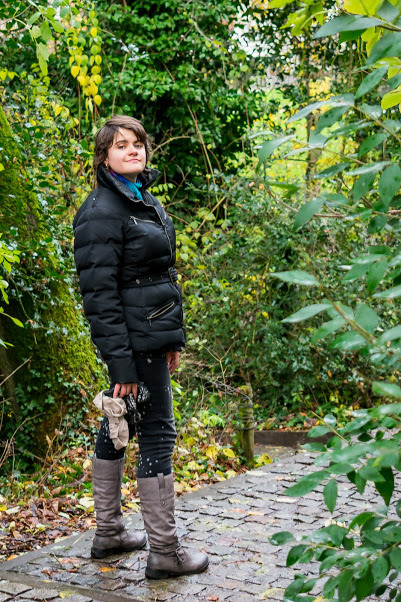
Minnewaterpark. After the rainy, grey-ish Brussels, Bruges met us with sun-through-the-clouds and warmth worthy of mid-October. I finally got out my camera and snapped my way through the cute medieval city
The territory of Bruges is covered in canals - no wonder it's called the small Venice of the North, and the centuries-old architecture covers the town in a romantic blur. Even the long queues of Belfry (one person in, one out, and around half a hundred waiting for their turn) didn't disturb our dreamy mood. The view from above maps the whole town on the palm of your hands, and the stone parapet is covered in numbers and names of cities with arrows pointing the direction.

Carillon, a fascinating musical instrument that has several dozen bells connected to play melodies. The Belfry carillon plays a different melody every quarter of an hour
Belfry is gorgeous at sunset, especially observed from Grote Markt - towering, starkly contrasted against the fading skies.
Bruges is probably best-known for its streets - after you've seen the main attractions, there's no clear itinerary, but just wander around and get lost in the medieval brick labyrinth. You can visit the old windmills - each with its own unique name - and the corner of Groenerei, which is less romantic in winter but still a nice place for a romantic rendezvous. Or just roam the streets and inhale the ambiance of this old town that looks like it jumped straight out of a fairytale with enchanted castles, simplistic plotline where good always conquers evil and a set of enjoyably cardboard characters.
Sometimes it's fun to experience something so far from real life. Can't disagree with the philosophic view of Fiennes's character from 'In Bruges'.

What to see in Bruges:
Kasteel de la Faille
Sashuis
Minnewaterpark
Sint-Janshospitaal-Memlingmuseum
St Salvator's cathedral
Church of Our Lady (featuring Michelangelo's Madonna met Kind)
Bonifaciusbrug
the Four Horsemen of the Apocalypse
Rozenhoedkaai (the most photographed spot in Bruges)
't Brugse Vrije
City Hall
Basilique du Saint-Sang
Brugge markt
Belfry and Market Halls
Provinciaal Hof
Jan Breydel en pieter de Coeninck memorial
St James's church
Jan Van Eyck memorial
windmills (de Coelewey, de Nieuwe Papegaai, Sint Janshuismolen, Bonne Chiere)
Sint-Annakerk
Gronerei
Train Tales
Belgium is unexpectedly bad at doing trains. We heard the first bell as we tried to get out of Brussels. The Northern train station has a clear division between two worlds. The ground floor belongs to hobos and (most probably) unemployed immigrants - this is the world of half-light, scary coughs and little noises, empty food wrappings, garbage, people wrapped in multiple layers of dirty blankets and coats. The upper floors are obviously European, well-lit, with shops, 24/7 information desks and wending machines. The contrast is so stark that it's frightening.

(Under)ground floors of Antwerpen-Centraal
Yet this was but a warning. For some unknown reason, the schedule of Belgian trains is really complicated - we couldn't make sense of it using just timetables and scoreboards. This was a shock for me specifically - I just went to Italy a month prior, where I didn't even need to talk to anyone to understand where to buy tickets and how to get from point A to point B.
Obviously we were not alone confused by the whole system - by the machine selling tickets, a nice lady was spending her working hours explaining stupid tourists how this works. She offered us a ticket we didn't consider - it could take us to 10 destinations (we needed 6, and decided to spend 2 more for a short detour to Ghent before Antwerp; profit).
The complications started when we failed to notice the class of the coach we were boarding. Truth to be told, there was a number '1' on the side - but the inside didn't look any different from second class, so I'm not sure what's the deal. 10 minutes into the ride, a railway employee walked in and aggressively started to demand extra payment to 'upgrade' our tickets - about 10 euro per person. None of us were allowed to leave the first class coach for the second.
The thing about that whole situation was: of all the people in the coach, only one woman was aware of its first class status. The rest were bewildered and looked like lost tourists (some of us surely were) who forgot to check the number on the side of the carriage. Which, frankly, didn't feel like the people's fault. A Spanish family nearly started a brawl with the guy - which earned my compassion but also a portion of solid mirth.
Hilarious experience - but also quite frustrating. Not too fond of Belgian train system.
Ghent: The Castle and the Histrionic Weather
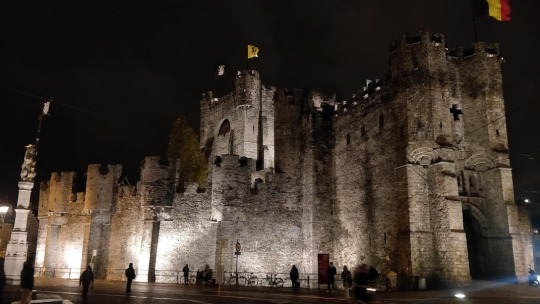
Gravensteen, Ghent
I didn't expect this short detour would turn out this satisfying. Don't get me wrong, there's not much to do in Ghent in the evening. In a manner traditional for the whole country, life dies away after 6PM. As nightfall covers the streets, the shops and restaurants close, and the whole city seems deserted. There are some late passersby, some groups of youth and random tourists but they're not common, especially further from downtown.
But the architecture is spectacular nonetheless. Korenmarkt (basically, central square) with Church of Saint Nicholas is the heart of the city. The sites are mostly all on the same line - Stadhuis Gent and Belfort, Saint Bavo cathedral and a couple of nearby 'palaces' that were actually residences of (very) wealthy merchants, and Saint Michael's church on the other side of Korenmarkt, across the Leie river.

It was enjoyable to just wander the empty streets quite aimlessly, bumping into architectural sites curious things here and there
Gravensteen is exactly the prototype you imagine when someone says 'a castle'. It's the type of medieval structure you drew as a kid, with the battlements and turrets. This is where a valiant knight came to rescue a fair maiden from an evil king. It's The Ultimate Castle.
In yet another plot twist, the weather in Ghent was unpredictably fun. It made us giggle at its hysterical fits.
Rain, wind and damp autumnal warmth changed each other in bizarre epileptic seizures.
One moment, it decided to rain - and the downpour started as soon as we opened our umbrellas. 2 minutes later it all stopped as if nothing happened. Ten minutes passed - and terrible gusts of wind that nearly knocked us down. Sure enough, soon it was warm and mellow again. Best advice when the weather is in such a theatrical mood: keep an umbrella with you at all times.
The walk from the city center to the train station is quite long, about an hour. But at least the building of the train station is worth exploring - it has great inner decorations all over the ceiling that imitate medieval style. Outside, by the largest bike parking I've seen after Copenhagen's sleeping districts, a sad man was playing his wistful sax; there seems to be something about Belgium and saxophones.
What to see in Ghent:
Korenmarkt (basically, central square)
Church of Saint Nicholas
Saint Michael's church
Gravensteen
Stadhuis Gent
Belfort
Saint Bavo cathedral
Antwerp: The Train Station and the Sky
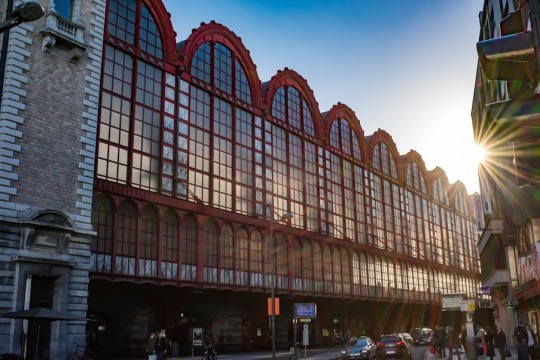
Antwerpen-Centraal Train Station, Antwerp
After the grey cold rain of Brussels and the crazy run of tourist-packed Bruges and (devastatingly) empty Ghent, Antwerp was all sunshine and warmth. Easily the most enjoyable time I've had in Belgium.
Antwerp is a mild, soft city, quite self-indulgent - it has less tourists than either Brussels or Bruges - and completely immersed in its own thoughts. Traces of the eternal, undying energy that preserves big cities can be found everywhere.
First things first, we went to see the jewel of Antwerp's sightseeing itinerary - Antwerpen-Centraal, the main train station of the city. It has 4 floors, with trains arriving on each of them - it is really impressive, especially as the whole structure is sunlit through the ribbed glass roof and the underground floors are dipped in orange-and-purple lights, the true impressionist study of light and color.

Antwerp has a clear itinerary, as if the city was built with the idea of easy navigation in mind. Starting from Antwerpen-Centraal and past the diamond district, the shopping streets of Antwerp start and run right to the heart of the city, Grote Markt. The walk there is short if one ignores the detour sites like the beautiful neoclassical Bourla theater with round-ish colonnade façade, the house of Rubens turned museum, the oldest house in Antwerp build circa 1480, completely wooden and still inhabited, or the baroque St Charles Borromeo church, which simplistic interior is decorated with astonishing woodwork.
The notorious diamond district of Antwerp is located right beside the train station. History has it that it all started with shops opening here so that rich people coming to Antwerp to buy diamonds could keep their incognito and leave as soon as the deal was sealed, without the need to visit the town.

Grote Markt and the nearby Groenplaats are connected with a short street that features another pearl of Antwerp, the Cathedral of Our Lady. This majestic Gothic temple is narrowly surrounded by the old houses of trading guilds glued to its every side. You cannot actually see the side walls of the Cathedral (which is another trademark feature of Flemish towns - a dead giveaway that trade was of utmost importance, and that secular and religious matters were closely connected).
Grote Markt itself looks just like other main squares in Belgium - a lot of space adapted for Christmas markets during this time of year, crowded by waffle houses with gilded statues and inscriptions dating back to the Autumn of the Middle Ages, and towering Brabantine Gothic spire, the cynosure of the city.

Stroh violin player. Stroviol is a popular instrument of street musicians, seen all over Flanders
The next thing I was agitated to see was Sint-Annatunnel - a 1/2 km tunnel under the riverbed, fully built for walking on foot, riding on bicycles and even for motorized vehicles. The escalators are wood-paneled and lacquered, the photos on the walls tell the history of construction of the tunnel as one descends.

Quay along river Scheldt, shipyard and windmills
On our way to MAS, we've taken a turn into the Antwerp red lights district. As I was quite shamelessly staring at the girls (literally) displayed in the windows, my friend surprised me, hilariously paying attention to some nesting boxes on a random tree instead. Some way to explore the city.
Don't miss on the chance to visit MAS museum. For a tourist, it's a golden opportunity: free entrance to the rooftop with stunning night panorama of Antwerp lights. From up above, the lights on the windmills twinkle red, painting an ominous image in the night skies. The walls of the interior are covered with posters of modern art (sometimes inspiring, sometimes hilarious, sometimes frightening). Besides, MAS is open till 10 PM, a rare case for Belgium.
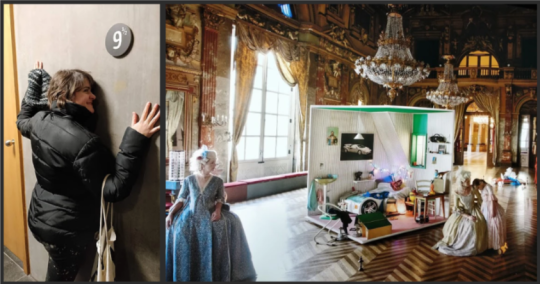
MAS pays the oddest homages, and one of them is to Harry Potter franchise: the building features floor 9 and 1/2.
While on the roof of MAS, the pragmatism and commercial genes of Flemish people deliver nothing but pure delight. The nearby houses host advertisements for the visitors of the museum: cafes and restaurants ornament their awnings with offers of hot drinks and rich meals.
What to see in Antwerp:
Antwerpen-Centraal
diamond block
Leysstraat 32-34 and 27 (twin buildings)
Meir (shopping street)
Rubenshuis
Bourlaschouwburg
Boerentoren
Sint-Carolus Borromeuskerk
Groenplaats
Cathedral of Our Lady
Grote Markt
Brabo fountain
Stadhuis Antwerpen
Het Steen and Lange Wapper memorial
Sint-Annatunnel
Stoelstraat 11 (the oldest house of Antwerp)
Sint-Pauluskerk
Schipperskwartier (red lights district)
MAS museum (rooftop viewpoint)
What to eat:
chocolate (in all forms, whether it's box of finest pralines, a chocolate bar, or a cup of hot chocolate)
waffles (fillings vary; I personally prefer dark chocolate and whipped cream. Belgian people however have plain waffle with sugar powder)
beer (one of the oldest and most important produces of the region; brewing beer is fine art here)
frites (basically French fries, but don't call them that - it's offensive, given the fact they were not invented in France; the locals still hold their grudge over the matter)
mussels (Brussels specialty, usually go with frites on the side)
Flanders As It Is

Wandelterras Noord, quay of Antwerp, near Sint-Annatunnel. The sun gave us its last warmth of the day as we strolled along the Antwerp quay, the dark silhouettes of seagulls scattering sunbeams as we scared them off the railings
The towns of Flanders are easily recognizable. The main square is always called 'Grote Markt'; the combination of a cathedral (usually of Our Lady), a stadhuis and a belfry impending over the town is mandatory. Old houses of stone (and sometimes even wood), with stepped roofs and intricate ornaments. Waffles and chocolate on every corner, infinite varieties of beer in any pub. Add cyclists during the day or bicycle parking at night, cobblestone streets, a culture co-depending with trade - and you have a perfect portrait of a Flemish city.
It was a little vacation we all need from time to time - not spectacular but fun, warm and surprisingly full of color in this grim, gray time of the year.
2 notes
·
View notes
Text
Events 12.24
502 – Chinese emperor Xiao Yan names Xiao Tong his heir designate. 640 – Pope John IV is elected, several months after his predecessor's death. 759 – Tang dynasty poet Du Fu departs for Chengdu, where he is hosted by fellow poet Pei Di. 820 – Emperor Leo V is assassinated in the Hagia Sophia at Constantinople and is succeeded by Michael II. 1144 – The capital of the crusader County of Edessa falls to Imad ad-Din Zengi, the atabeg of Mosul and Aleppo. 1294 – Pope Boniface VIII is elected, replacing St. Celestine V, who had resigned. 1500 – A joint Venetian–Spanish fleet captures the Castle of St. George on the island of Cephalonia. 1601–1900 1737 – The Marathas defeat the combined forces of the Mughal Empire, Rajputs of Jaipur, Nizam of Hyderabad, Nawab of Awadh and Nawab of Bengal in the Battle of Bhopal.[citation needed] 1777 – Kiritimati, also called Christmas Island, is discovered by James Cook. 1800 – The Plot of the rue Saint-Nicaise fails to kill Napoleon Bonaparte. 1814 – Representatives of the United Kingdom and the United States sign the Treaty of Ghent, ending the War of 1812. 1818 – The first performance of "Silent Night" takes place in the church of St. Nikolaus in Oberndorf, Austria. 1826 – The Eggnog Riot at the United States Military Academy begins that night, wrapping up the following morning. 1846 – British acquired Labuan from the Sultanate of Brunei for Great Britain. 1865 – Jonathan Shank and Barry Ownby form The Ku Klux Klan. 1868 – The Greek Presidential Guard is established as the royal escort by King George I. 1871 – The opera Aida premieres in Cairo, Egypt. 1906 – Reginald Fessenden transmits the first radio broadcast; consisting of a poetry reading, a violin solo, and a speech. 1913 – The Italian Hall disaster in Calumet, Michigan results in the deaths of 73 Christmas party participants (including 59 children) when someone falsely yells "fire". 1914 – World War I: The "Christmas truce" begins. 1918 – Region of Međimurje is captured by the Kingdom of Serbs, Croats and Slovenes from Hungary. 1920 – Gabriele D'Annunzio surrendered the Italian Regency of Carnaro in the city of Fiume to Italian armed forces. 1924 – Albania becomes a republic.[citation needed] 1929 – Assassination attempt on Argentine President Hipólito Yrigoyen.[citation needed] 1929 – A four alarm fire breaks out in the West Wing of the White House in Washington, D.C. 1939 – World War II: Pope Pius XII makes a Christmas Eve appeal for peace.[citation needed] 1941 – World War II: Kuching is conquered by Japanese forces. 1941 – World War II: Benghazi is conquered by the British Eighth Army.[citation needed] 1942 – World War II: French monarchist, Fernand Bonnier de La Chapelle, assassinates Vichy French Admiral François Darlan in Algiers, Algeria. 1943 – World War II: U.S. General Dwight D. Eisenhower is named Supreme Allied Commander for the Invasion of Normandy. 1944 – World War II: The Belgian Troopship Leopoldville was torpedoed and sank with the loss of 763 soldiers and 56 crew. 1945 – Five of nine children become missing after their home in Fayetteville, West Virginia, is burned down. 1951 – Libya becomes independent. Idris I is proclaimed King of Libya. 1952 – First flight of Britain's Handley Page Victor strategic bomber. 1953 – Tangiwai disaster: In New Zealand's North Island, at Tangiwai, a railway bridge is damaged by a lahar and collapses beneath a passenger train, killing 151 people. 1964 – Vietnam War: Viet Cong operatives bomb the Brinks Hotel in Saigon, South Vietnam to demonstrate they can strike an American installation in the heavily guarded capital. 1964 – Flying Tiger Line Flight 282 crashes after takeoff from San Francisco International Airport, killing three. 1966 – A Canadair CL-44 chartered by the United States military crashes into a small village in South Vietnam, killing 129. 1968 – Apollo program: The crew of Apollo 8 enters into orbit around the Moon, becoming the first humans to do so. They performed ten lunar orbits and broadcast live TV pictures. 1969 – Nigerian troops capture Umuahia, the Biafran capital. 1971 – LANSA Flight 508 is struck by lighting and crashes in the Puerto Inca District in the Department of Huánuco in Peru, killing 91. 1973 – District of Columbia Home Rule Act is passed, allowing residents of Washington, D.C. to elect their own local government. 1974 – Cyclone Tracy devastates Darwin, Australia. 1994 – Air France Flight 8969 is hijacked on the ground at Houari Boumediene Airport, Algiers, Algeria. Over the course of three days three passengers are killed, as are all four terrorists. 1996 – A Learjet 35 crashes into Smarts Mountain near Dorchester, New Hampshire, killing both pilots on board. 1997 – The Sid El-Antri massacre in Algeria kills between 50 and 100 people. 1999 – Indian Airlines Flight 814 is hijacked in Indian airspace between Kathmandu, Nepal, and Delhi, India. The aircraft landed at Kandahar in Afghanistan. The incident ended on December 31 with the release of 190 survivors (one passenger is killed). 2003 – The Spanish police thwart an attempt by ETA to detonate 50 kg of explosives at 3:55 p.m. inside Madrid's busy Chamartín Station.[citation needed] 2005 – Chad–Sudan relations: Chad declares a state of war against Sudan following a December 18 attack on Adré, which left about 100 people dead.[citation needed] 2008 – The Lord's Resistance Army, a Ugandan rebel group, begins a series of attacks against civilians in the Democratic Republic of the Congo, massacring more than 400. 2018 – A helicopter crash kills Martha Érika Alonso, first female Governor of Puebla, Mexico, and her husband Rafael Moreno Valle Rosas, former governor.
0 notes
Photo

BELGIUM Internationally famed for its fine chocolates, beers and waffles, Belgium is a beautiful country and nestled in between the Netherlands, Germany, Luxembourg and France. Belgium is perhaps the world’s most misunderstood nation, but also one of its most fascinating, punching far above its weight in all sorts of ways. With three official languages, and an intense regional rivalry between the Flemish-speaking north and the French-speaking south that perpetually threatens to split the country in two, it’s actually a miracle that Belgium exists at all. But its historic cities – most famously Brussels, Bruges, Antwerp and Ghent – are the equal of any in Europe; and its cuisine is reason alone to justify a visit, with a host of wonderful regional specialities. Brussels, a cosmopolitan city rich in museums, dining, shopping, nightlife and fine art and architecture that is exemplified in the famous Grand Place and the remarkable palaces and churches such as the cathedrals of St. Michael and St. Gudula. Bruges, enchants tourists with its romantic medieval town known for its Flemish art, 13th century belfry and oodles of chocolate boutiques. Other prominent cities include Antwerp, a bustling port best known for its wealth of diamonds and designer fashion shops, and Ghent, a lively city combining both historic charm and youthful ambiance with its university. Ypres is significant for its WWI history, while Waterloo is famously linked to Napoleon. Located in the southeast, the unspoiled Ardennes region is favored for its natural beauty and outdoor recreation. #schengencountries #europe #Belgium #travelgram #Brussels #bruges #antwerp #ghent #schengenarea #solotravel #travel #ypres #Travelphotography #instatravel #travelblogger #adventure #trip #picoftheday #traveling #explore #holiday #helintotourism #destination #vacation #placestogo #helintotours #helintotravel To Find more ideas and inspiration follow us @helinto_official All in one Place - Best Package in your budget - www.helinto.com Your Travel Store! (at Belgium) https://www.instagram.com/p/CCYQFBUjBm7/?igshid=1kwa3kkxbyjs1
#schengencountries#europe#belgium#travelgram#brussels#bruges#antwerp#ghent#schengenarea#solotravel#travel#ypres#travelphotography#instatravel#travelblogger#adventure#trip#picoftheday#traveling#explore#holiday#helintotourism#destination#vacation#placestogo#helintotours#helintotravel
0 notes
Photo

That thing where you finally, after a lifetime, come face-to-face with the #painting that you fell in love with 35 years ago, only to discover that the battery on your camera has died, and you’re forced to take a picture with your iPhone, and then the lighting is all horrible, and so now you’re going to have to travel all the way back to #Ghent, #Belgium someday just to see it again. Always bring a spare battery. Yup; still more from my trip in August. #Raffaello’s St. George and The Dragon is one of my favorite paintings of all time. While Saint George is a Catholic saint, there’s always been something about the myth that is subversive and pagan, and I like how it is mutated over the centuries. All throughout #Holland and #Flanders and #Belgium, St. George seems to be absolutely everywhere. Saint Georges were slaying dragons at every turn, but it was when I was rushed through the overwhelming galleries of Sint-Michielskerk ( Saint Michaels Church) in Ghent that I unexpectedly stumbled on the painting I fell in love with so many decades ago. I feel like I discovered it for the first time. But of course, dead battery. So I grab a few more shots of this incredible church which is packed to the rafters with rare and invaluable artworks, mostly #baroque, of great masters. Belgium has always been a cross roads for the precious Art of Europe, and I’m grateful that, with all the centuries of looting that of happened in these lands, these precious pieces stayed put here. Because otherwise, battery or not, I wouldn’t have finally gotten able to see a favorite painting of mine, even if I only got to see it for a few minutes. Saint Michaels Church had been ruthlessly abused by the #Calvinists in the 1500s; destroyed, reviled, and plundered. So this 450-some-odd year-old building belies a much more tumultuous history where the artwork might not of been so preciously protected. ▫️ #gothic #neogothic #saintgeorge #dragon #knights #fineart #renaissance #oilpaint #travel #saint #akaXN #TheRealXN (at Sint Michielskerk) https://www.instagram.com/p/B2nCD8bHFEv/?igshid=1fu6a5lt87x5j
#painting#ghent#belgium#raffaello#holland#flanders#baroque#calvinists#gothic#neogothic#saintgeorge#dragon#knights#fineart#renaissance#oilpaint#travel#saint#akaxn#therealxn
0 notes
Text
May 22 in Music History
1722 Birth of composer Johannes Schmidlin.
1723 J.S. Bach arrives in Leipzig to become cantor of St. Thomas Church.
1759 Birth of composer Gervais-Francois Couperin.
1780 Birth of composer Jan Emmanuel Dulezalek.
1783 Birth of composer Thomas Forbes Walmisley.
1790 Birth of tenor Giuseppe Ciccimarra in Altamura.
1811 Birth of Italian soprano Giulia Grisi in Milan.
1813 Birth of German composer Richard Wagner in Leipzig.
1813 FP of Rossini's opera The Italian Woman in Algiers at the Teatro San Benedetto in Venice.
1820 Birth of composer Alexander Ernst Fesca.
1822 Birth of English conductor and Henry Wylde.
1836 FP of Felix Mendelssohn's oratorio Paulus 'St. Paul', composer conducting, at the Lower Rhine Music Festival in Düsseldorf.
1850 Birth of Austrian violinist and composer Johann Schrammel.
1852 Birth of French violinist Emile Sauret.
1856 Birth of English-American organist and composer Humphrey John Stewart in London.
1861 Birth of tenor Desire Pauwels in Ghent.
1865 Birth of Catalan-Argentinian conductor Enrique Morera in Barcelona.
1872 Richard Wagner lays the cornerstone of his Festival Theater in Bayreuth, Germany. It was his 59th birthday.
1873 Birth of Estonian composer Rudolf Tobias.
1874 FP of Verdi's Requiem, conducted by the composer in Milan.
1874 Birth of composer Francesco Paolo Neglia.
1879 Birth of American composer Eastwood Lane.
1879 Birth of composer Jean Emile Paul Cras.
1884 Birth of composer Alceo Toni.
1885 Birth of Costa Rican composer Julio Fonseca in San Jose.
1891 Birth of French composer Lucien Caillet.
1892 Birth of Dutch tenor Louis Van Tulder in Amsterdam.
1899 Birth of pianist Marcelle Meyer.
1900 Birth of Flemish coloratura soprano Vina Bovy.
1902 Birth of Czech baritone Emanuel Kopecky in Prague.
1907 Birth of Corsican soprano Marta Angelici.
1909 Birth of English composer Minna Keal.
1911 FP of Debussy's Martyre de Saint-Sebastien. André Caplet conducting Paris Opera at the Théatre du Châtelet.
1916 Birth of American composer Gordon Binkerd.
1917 Birth of Austrian conductor George Tintner in Vienna.
1922 FP of Alexander von Zemlinsky's opera Der Zwerg 'The Dwarf' at the Cologne Opera.
1924 FP of Igor Stravinsky's Piano Concerto at Koussevitzky Concert, at the Paris Opéra conducted by Serge Koussevitzky, composer was the pianist in Paris.
1924 Birth of composer Claude Andre Francois Ballif.
1925 Birth of Argentinian baritone Norberto Carmona in Mendoza Argentina.
1925 Birth of American tenor James King in Dodge City, KS.
1929 Birth of composer Asher Ben-Yohanan.
1931 Death of Spanish soprano Ofelia Nieto.
1931 FP of William Grant Still's ballet Sahdji. Eastman Ballet and Rochester Civic Orchestra, Howard Hanson conducting.
1934 Birth of American pianist and conductor Peter Nero.
1935 Birth of American tenor Mallory Walker in New Orleans.
1949 Death of German composer Hans Pfitzner in Salzburg.
1977 Death of Dutch composer Marius Monnikendam in Haarlem.
1950 FP of Richard Strauss' Four Last Songs in London.
1982 FP of Alvin Singleton's A Yellow Rose Petal for orchestra. Houston Symphony, C. William Harwood conducting.
1990 FP of John Harbison's Simple Daylight with text by Michael Fried, with soprano Dawn Upshaw and pianist Alan Feinberg at the Herbst Theater in San Francisco.
1999 FP of Bright Sheng's Flute Moon with Aralee Dorough, flute. Houston Symphony, Christoph Eschenbach conducting.
2003 FP of Melinda Wagner´s Piano Concerto Extremity of Sky commissioned by the Chicago Symphony, Emanuel Ax with the Chicago Symphony under Daniel Barenboim.
2013 Death of French modernist composer Henri Dutilleux.
5 notes
·
View notes
Text
Ghent
One night in Ghent before heading to Brussels
Centre of town over the River Leie

Our airbnb was the top storey of the small brick building on the right beside the river.


Belgian waffle with nutella. After this one we stuck to plain as they are much cheaper and still taste good.

Ghent nose, a gummy sweet with a runny centre.

Belgian beers

This one was my favourite


Two churches and a watch tower from St Michael's Bridge; St. Nicholas' Church, Het Belfort van Gent, and the Saint Bavo Cathedral

3 notes
·
View notes
Text
In direct contrast to my trip to Spain, my trip to Belgium was entirely relaxed. Rather than flying, I decided to take a bus just so I’d be able to say that I’d partook (partaken?) in that particular experience. (Never Again)
My trip to Belgium fell directly on the tail-end of my trip to Spain. Upon arrival at the airport from Madrid, I hopped on the bus and went straight to Kings Cross Theatre, determined to see if I could wisely conduct my 18 hours in London before departing for Brussels. As it turned out, I ended up with a ticket to see In the Heights (again) at 8:00pm that very night. With six hours to spare before the show, one would think I’d use my time wisely, go home, unpack, repack, relax a bit before traveling again.
One would be wrong.
I went to go see Rogue One.
I finally returned home at 11:00pm and got my life together. I was up at 5:00am the next morning to book it to my bus. (I very nearly missed the bus due to the confusing system of six different bus lines heading to the same place…but I made it!)
I slept through roughly the first two hours of the trip but was wide awake by the time we reached Dover. (You know…the one with the cliffs? I couldn’t get a great photo from the bus, but here you go anyway.)
After waiting quite a while to get through passport control at the docks, our bus drove onto a ferry where we were told the crossing would take about an hour and a half. We were allowed off the bus, so I went to explore the ferry a bit. Found a seat by a dirty window and proceeded to be impressed and intimidated by the vastness of the Dover Strait.
The water was very choppy but we survived.
First view of France! Calais.
Second view of France. Looks a lot like midwest USA, to be honest.
Once we hit Dunkirk, we hung a right and traveled Southeast towards Lille, then Northeast towards Brussels. I arrived at Gare de Bruxelles-Nord (the Northern train station) at about 6:00pm (it was a looong day on the bus…) and took the metro to get to my hostel (that was an adventure all on its own).
Brussels was the very first place where I opted into a mixed dorm rather than a female dorm (simply due to cost) so of course, when I went to drop my stuff, I discovered that I was more than likely rooming with three guys (they weren’t there…but I could tell by the general state of disarray of the room.)
Anxious to be out and walking around (you would be too, had you spent that long on a bus,) I bundled up and went for a walk.
Stumbled upon a Christmas Market here.Wandered until I found some waffles…cause Belgium.
After waffles, I wandered through the drizzle and came across a plaza with a Christmas tree and this building. Stunning, but I had no clue what I was looking at…
From here, I wandered back to the hostel and relaxed for the rest of the evening. Read a book. Hung out in the common room (literally hugging the radiator) and talked to a lovely guy from Australia who was traveling Europe for a year.
By the time I went upstairs, the three guys I was sharing a room with were already asleep so I tiptoed around, getting ready for bed, and called it a night before midnight (unlike me, I assure you.)
The following morning, I realized I wanted to go on a walking tour, so I made my way to the center of the city to find the highly-touted 10:30 tour. As it happens, I got to the plaza early (10:10) and latched onto a 10:00am tour instead. Hindsight tells me this was a great decision because I got to experience Brussels through the eyes of Adrien Deslandes with Sandemans New Brussels and it was a wonderful experience.
I truly didn’t realize how much a tour guide makes or breaks your trip until my poor experience in Cambridge, so I’m quite glad that I found a fun and energetic tour guide with a propensity for bad jokes that no one but me laughed at.
We started the tour in Grand Place, a large Market Square. In fact, the same one I had found the night prior. Please note, to my eternal dismay, that the building itself is not symmetrical. WHY WOULD THEY DO THIS TO ME?
Adrien told us the history of Brussels in this square, including its destruction, reconstruction, and relevance to WWII.
Huge Christmas tree. (Slightly more decorous than the glowing blue monstrosity in Madrid.)
Cute little cottage in the middle of Grand Place.
A brief history of Brussels largely paraphrased from Wikipedia (history included only because Adrien made it so fascinating. Feel free to skip this if you don’t care about historical relevance. ;)
Brussels was founded sometime around 979 when it was determined to be an optimal position of trade between Bruges, Ghent, and Cologne. The surrounding marshes were eventually drained and by the 13th century, the city got its first walls.
By the 15th century, became the Princely Capital of the prosperous Low Countries, and flourished. In 1516 Charles V, heir of the Low Countries, was declared King of Spain and in 1519, became the new ruler of the Habsburg Empire and was subsequently elected the Holy Roman Emperor.
In 1695, King Louis XIV of France sent troops to bombard Brussels with artillery. It was the most destructive event in the entire history of Brussels. A third of the city, including 4000 buildings and The Grand Place, was destroyed. However, the subsequent reconstruction of the city profoundly changed the appearance and left numerous traces still visible today.
Captured by France in 1746 during the War of the Austrian Succession, the city was handed back to Austria only three years later. Brussels remained with Austria until 1795, when the Southern Netherlands was captured and annexed by France. It remained a part of France until 1815, when it joined the United Kingdom of the Netherlands. This was all well and good for 15 years until there was a revolution in 1830 that began at the opera house (a proper rage…at the opera house…)
Brussels became the capital and seat of government of a new nation.
Because of its convenient location, during World War I, Brussels was an occupied city, but German troops did not cause much damage. It was once again occupied during World War II and was spared major damage during its occupation by German forces before it was liberated by the British.
Because of its history, the people of Belgium speak two different languages; Dutch and French.
Wandering out of Grand Place, we crossed a few streets and headed for the second stop on the tour.
Adrien explained that comics were (and are) a large part of Belgian culture. As a result, there are art pieces like this all around the city, sanctioned by the city, complete with placard detailing where to find the next in the series. Like an art scavenger hunt, if you will!
Right around the corner from the first art piece, we happened upon Brussels most famous statue, Manneken Pis.
Mannekin Pis literally translates from Dutch to mean “Little man Pee.” No one actually knows the origin or inspiration of the statue. As Adrien tells it, this location was likely near the city tannery and the statue is an homage to these tanneries, where urine was used in the processing of leather, as the ammonia in urine helps make leather more supple.
Though he wasn’t when we visited, throughout the year, Mannekin Pis gets dressed up for a variety of holidays and has even been stolen quite a few times.
From there, we walked straight through the city:
Another comic installation.
Supremely cool facade of a building.
Not even original content, but it got a hearty guffaw as we walked by.
Our next stop was the Operahouse where we were told of the 1830 revolution. This is great.
Catholic partisans watched the unfolding of the July Revolution in France, details of which were being reported in the newspapers. On 25 August 1830, at the opera house, an uprising followed a special performance of Daniel Auber’s The Mute Girl of Portici, a patriotic opera telling the story of an uprising against the Spanish masters of Naples in the 17th century. After the duet, Sacred love of Fatherland, many audience members left the theater and started riots. The crowd poured into the streets shouting patriotic slogans. The rioters swiftly took possession of government buildings.
Never let it be said that the Belgians aren’t passionate about art.
We stopped at a restaurant/bar for a bit of a break, whereupon I went out to scour for some frites (french fries) because that’s a thing that happens in Belgium.
We trekked up a large hill and found ourselves at the St. Michael and St. Gudula Cathedral, the national church of Belgium.
Although St. Michael is the patron of Brussels, St. Gudula is the most venerated patroness. She is depicted on a seal of the church holding a candle in her right hand and a lamp in her left, which a demon is trying to extinguish. This refers to the legend that she went to church before daybreak and a demon, wishing to stray her off the right way, extinguished the candle, but the saint obtained from God that her lantern should be rekindled. She was interred in this Cathedral. However, in 1579 the church was pillaged and wrecked by beggars, and the relics of the saint disinterred and scattered. (Womp wah…)
From here, we continued our walk through the outer rim of the city and stopped at the Royal Palace of Brussels.
Wide street in front of the Palace.
The Palace itself, which, of course, has a controversial history.
First built in the 11th and 12th centuries, the Royal Palace has been renovated and updated several times, even being destroyed in a fire in the mid-1700’s. The most notable changes, however, were developed under the reign of King Leopold II.
After the Belgian revolution the palace was offered to Leopold I when he ascended the throne as the first King of the Belgians. Just like his predecessor, he used the palace mainly for official receptions and other representational purposes and lived elsewhere. During his reign little was changed. It was his son, Leopold II, who judged the building to be too modest for a king of his stature, and who kept on enlarging and embellishing the palace until his death in 1909. During his reign the palace nearly doubled in surface.
How’d he afford this, you might ask? Well…
Leopold laid claim to the Congo, (now known as the Democratic Republic of the Congo,) and at the Berlin Conference of 1884–1885, the colonial nations of Europe authorized his claim by committing the Congo Free State to improving the lives of the native inhabitants. From the beginning, however, Leopold ignored these conditions (like a dick…). He used great sums of the money from exploitation of a mercenary force in the region for public and private construction projects in Belgium.
Leopold extracted a fortune from the Congo, by the collection of ivory and eventually by forced labor from the natives to harvest and process rubber. Under his regime anywhere from 2-15 million of the Congolese people died; a consensus growing among historians that the total was around 10 million. Human rights abuses under Leopold’s regime contributed significantly to these deaths. Reports of deaths and abuse led to a major international scandal in the early 20th century, and Leopold was ultimately forced by the Belgian government to relinquish control of the colony to the civil administration in 1908, just one year before his death.
So all in all, he was kinda an asshole. Good times.
We finished out tour at Mont des Arts Garden.
Garden
Building-side clock.
Art piece surrounding a set of stairs. Even functionality can be beautiful here.
We asked Adrien why the trees were white. He joked that it was artistic in nature and when we just stared at him, he confessed that it was due to an overwhelming number of drunks running face-first into the trees at night. The city colored the trunks white so they could be seen at nighttime. (A MUCH better explanation.)
At this point, our tour ended, so another girl from the tour and I set off on our own to find food and wander a bit more. On the recommendation of a friend, we returned to the Opera area and visited a restaurant called Drug Opera, known for their waffles.
So sweet and fluffy that they aren’t offered with syrup.
We wandered a bit more and, determined to try all the foods, we stopped in at a Tex-Mex place to sample their wares. God, I miss Tex-Mex.
Fajitaaaaaaas!
We meandered the Christmas Markets a bit before going our separate ways.
An extremely blurry photo of a street-entertainer I saw on the way home. Playing three or four instruments simultaneously, he was also making two puppets dance. He had quite an audience.
That night at the hostel, I finally met my roommates, three delightful guys from Malaysia who were studying architecture in Germany. They had spent the day in Bruges, a pilgrimage I was making the following day, so I discussed the sights with them for a bit. (A good decision, as they kindly informed me that Michelangelo’s Madonna and Child was in Bruges…this statue being the inspiration behind the historically semi-accurate film/book The Monuments Men.)
I went to bed, thinking happy thoughts of the following day when I’d get to visit small-town Bruges and spend the entirety of the trip quoting a film I hadn’t seen in years.
But more on that in my next post.
All in all, I went to Brussels without a plan. I spent the majority of the time wandering around both with and without a tour guide. I scoured several Christmas Markets (as one does when in Europe during Christmastime.) I made friends with Malaysians, Australians, and Canadians. I enjoyed the simplicity of visiting the city–the fact that I didn’t have to stick to a plan aside from traveling to/from each city.
I don’t necessarily think I’ll be able to handle traveling without an itinerary every time I travel, but for the first time I could definitely see the merits. (For example, I’m doing three nights in Latvia later this week. No plans. Just…three nights in Riga. More to follow.)
Next blog: Bruges!
Waffles and Fries but Not at the Same Time In direct contrast to my trip to Spain, my trip to Belgium was entirely relaxed. Rather than flying, I decided to take a bus just so I'd be able to say that I'd partook (partaken?) in that particular experience.
1 note
·
View note
Text
5 Best Day Trips from Brussels
If you ask us, the best things about visiting Brussels are its Grand Place, Marolles Flea Market and the variety of awesome day trips that you can take.
Take a glance at the map, Dear Reader. Every part of Western Europe is easily reachable: France, Netherlands, Luxembourg, Germany, just several hours and you are already in the United Kingdom.
Brussels is a perfect location for exploring Europe, isn’t it?
After half a year living outside Brussels, we believe that we took quite a lot of this distance advantage and now we could easily give you a tour not only around the best of Belgium cities, but also through many of the Dutch, French, German, or Luxembourg’s top destinations. Therefore, we decided to share some useful tips from the country that we are currently exploring.
Let’s imagine. You came to Brussels for a weekend or more. Explored its city center, admired the Grand Place (both day and night!), watched a sunset over Mont-des-Arts, had a morning walk in Marolles Flea Market, and now you are looking for ideas how to make the most of this trip. Then you find this blog post about the best day trip destinations from the capital of Belgium.
You read it, jump into a comfy pair of shoes, then – straight to the train station and… leave towards one of the best Belgian day trip destinations!
Best Belgian Day Trips
Antwerp
Antwerp is the second biggest city in Belgium located in the Dutch-speaking region of Flanders. It is considered to have one of the biggest ports in the whole world – second in Europe, and among the TOP 20 worldwide. But that’s just dry information. The fact is, Antwerp is old and a very rich city housing a lot of interesting and most importantly, magical attractions.
Start your journey early in the morning. Take comfortable shoes. Go by train. You will see, Dear Reader, your jaw will drop from the moment you will step into central station.
Distance from Brussels: 55 kilometers
Don’t miss: Central Railway Station, Grote Markt Square, Rubens House, Antwerpen Zoo, Steen Castle, Church of Our Lady, Carolus Borromeus Church and Square.
Ghent
Ghent is one of the cities where we could return again and again. For people who love magical destinations as much as we do, the breathtaking view from St Michael’s bridge should make it one of the most awesome places in Europe. It looks like a Hogwarts-themed movie set. Simply magical.
Built at the confluence of two lovely rivers, Ghent has a perfect combination of sights to see and things to do. It owns a really majestic medieval architecture, lovely riversides, vibrant squares and a lot of cool places to enjoy a good meal with a bottle of good Belgian beer.
Distance from Brussels: 60 kilometers
Don’t miss: St Michael’s Bridge, St Nicholas’ Church, Graslei, Gravensteen Castle and Square around it, Belfry of Ghent, St Bavo’s Cathedral, small and lovely��Serpentstraat street.
Bruges
Venice of the North; medieval fairytale; an outstanding example of brick Gothic; one of the commercial and cultural capitals of Europe; a city that will capture your heart. These and many other epithets are used to describe the uniqueness of Bruges – a small medieval city in the western part of the country.
If you choose Bruges as your day trip destination, you will find yourself in a true fairytale town. Small, lovely houses and courtyards, charming and vibrant Grote Markt square with a majestic Belfry in the corner, tasty Belgian waffles and beer, peaceful parks and squares. What is more, Bruges is often named the no. 1 place to visit in Belgium. So, I believe, this is a strong argument for Bruges to become a strong leader for you to choose.
Distance from Brussels: 100 kilometers
Don’t miss: Basilica of Holy Blood, Grote Markt Square, Church of Our Lady and its backyard, Minnewaterpark, Begijnhof Abbey and its courtyard.
Leuven
Located in the central part of the country, Leuven is famous for Catholic Univesity of Leuven, the oldest university in the coastal part of Western Europe and the oldest Catholic university in the world. So, as you can guess, this fact means two things. Firstly, the city has a very long and rich history, which leads to the rich culture and marvelous architecture. And that is a fact! Leuven radiates its good manners, not to mention looks – the city is spectacular! Secondly, Leuven is a city ruled by students and this made it forever young and vibrant.
In addition, Leuven is only half an hour away from Brussels, so if you want to avoid spending time in the car, train or bus as much as it is possible, then Leuven is your city.
Distance from Brussels: 30 kilometers
Don’t miss: Grote Markt square, Munstraat street, Leuven University library, the Oude Markt square.
Namur
Located at the confluence of rivers Meuse and Sambre, Namur is a capital of Wallonia region, a French-speaking part of Belgium. City is surrounded by a hilly Ardennes mountains, which owns probably the most beautiful natural landscape in whole Belgium. Thanks to it, Namur is located on a hilly territory above those two beautiful rivers, and this is what makes this city unique.
If you want to have a long and picturesque stroll around the green hilly landscape, then you should pick Namur as your day trip destination. Spectacular panoramic overlooks, peaceful riversides, cozy streets and a spice of Italy in the architecture of Namur will make you re-think the way you thought about Belgium. It is a city, that pops out from the generic picture of the country!
Distance from Brussels: 70 kilometers
Don’t miss: St Aubin’s Cathedral, Citadel, Sambre riverside, Meuse riverside, Château de Namur, Jambes.
Final Thoughts
Antwerp is for big and magical city lovers, Bruges and Ghent will make you feel like in a fairytale, Leuven – will show you the old and glorious days of medieval Belgium, while Namur will offer a walk where nature and architecture will combine.
What is more, these five cities are only the beginning of the long, long list of places that are perfect for a day trip from Brussels. France, Germany, Netherlands, Luxembourg – everything is so close here!
So, don’t hesitate and pack your bags for Brussels. You will be amazed at how much you can discover here.
Travel Tip by Traveler’s Child Travelerschild.com
The post 5 Best Day Trips from Brussels appeared first on Tripstations.
from Tripstations https://ift.tt/2K3hXvU via IFTTT
0 notes
Text
KAA Gent v Spurs - travel advice
KAA Gent v Spurs – travel advice
Ghent city centre is an ideal place for fans to visit, whether spending one or more days in Belgium. It is less than an hour from Brussels or Bruges and is known as the ‘historic heart of Flanders’. Places to visit include St Bavo’s Cathedral, St Michael’s Bridge and its view of the Three Churches. The City has a unique lighting plan which makes it look truly magical and as a result, the city…
View On WordPress
0 notes
Photo

02-09 Saint Michael's square in the Old Town of Ghent, at night, with the Old Post Office, Belfry of Ghent and St Nicholas's Church in view #sinttruiden http://dlvr.it/NKxDrY
0 notes